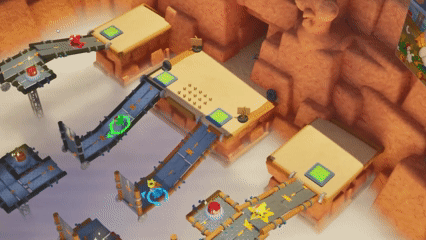Chick'Hen Show
Chick'Hen Show is a 4-player cooperative adventure game set in a crazy TV show!
The participants, 4 zany chickens, must cooperate to progress together, while competing to emerge victorious at the end of the show.
Make a good impression by helping your allies, impose yourself to keep your place in the rankings, or take advantage of the various events to turn the tables to your advantage: every style of play is possible in Chick'Hen Show!
Year: 2024/2025
Duration: 10 months
Role: Level Designer
Software used: Goolg Doc / Sheet, Photoshop, Unreal Engine


Presentation and background
As part of our final year of the Master's program, we had to work on a 1-year project, and the one I worked on as Level Designer was Chick'Hen Show.
This was the first major Unreal project I'd worked on, but the other major constraints were the multiplayer aspect, and the mix of competition and cooperation, which would have a major impact on the Level Design.
The main inspirations for this project were Four Swords Adventures for the cooperative gameplay, and Takeshi's Castle for the Show TV universe.
Gameplay
The aim of the game is to advance through the levels while accumulating points, so as to be top of the leaderboard at the end of the game.
Chickens can peck corn to earn points. Pecking can also be used to push elements of the scenery and other players, as well as to activate buttons and other GPE.
Chickens can also lay eggs, which they can use as projectiles to activate or move elements from a distance, but also to slow down other players.
Finally, it is possible to carry and throw objects, such as eggs or other elements of the scenery, but also and once again other players, whether to solve certain passages of the game or to make them lose score by throwing another player at them.
Most of the mechanics can therefore be used competitively or cooperatively, and they all interact with each other.



Game loop
The main difficulty on this project was managing the cooperative aspect. After many tests on how to force or not force the player to adopt a certain play style according to our intentions, I finally found a method that helped us a lot to better pace the levels and frame the players' play styles.
I divided the rooms according to their theme (cooperative or competitive) and then alternated between the two genres to build the levels. This allowed me to vary the style of play from one room to the next, diversify the objectives and provoke a “wow” effect, like a TV show.
However, this method could generate a certain monotony in the players' experience: systematically alternating between cooperative and competitive rooms became repetitive. So I began to integrate competitive elements into some of the cooperative rooms, and vice versa, to offer players more freedom and blur the expectations linked to the theme of each room.
Level's map
The demo is divided into three levels, each with its own decor, special features and so on.
In each, I used corn, barrels and buttons to guide players in the right directions.

Discover cooperative interactions, throwing eggs and other players to activate buttons you can't reach on your own.

Open area with several buttons to activate the output.

Players split into 2 groups of 2, each pair helping the other to move forward, with the first to arrive earning corn.

A linear zone in which players must cooperate throughout, but on very narrow paths, which encourages betrayal.
Guidance
To help the player easily identify the objective in a room, despite the potential attacks from other players, who can take up a lot of screen space, we set up a visual language with the artists.
Firstly, all the elements that players can use are on the scale of a chicken. Secondly, the paths are always light in color, while the scenery elements are darker.
Finally, buttons and pressure plates are generally highlighted by their positioning or by visual elements such as arrows or lines. In some of the larger rooms, such as the village, we've connected buttons to doors with cables, so that players quickly understand where to go and what to do, even when the camera is fully zoomed out.

Guide line (blue line), cable (white arrow), center of screen (important area) (red circle), scenery (green).



Iteration et Playtest
We had at our disposal KPIs (objectives that players had to reach for a room to be considered successful) for each room, as well as analytics on players' progress, time spent in each room, various score changes, etc. This helped us greatly to identify what was working or not, what needed to be corrected, etc.
This greatly helped us to identify what was working and what wasn't, what needed to be corrected, and so on. But above all, it allowed us to balance out the whole cooperative aspect.



